Manual

VzW SOHO
Installation Manual
2008. 04
Draft Ver 0.5

2
Modified Manual LIST
Manual issue DATE Modified List Remark
Ver 0.2 2007. 08. 02 First Draft
Ver 0.3 2007. 09. 11
Added Information
▶ Changed DIP S/W control method
▶ Appendix C. System Block
▶ Appendix D. Troubleshooting for the MPE25K
Ver 0.4 2007. 10.22. Added information
Added material name of each image
Ver 0.5 2008. 04. 21 ▶ Changed Installation Bracket
▶ Updated System Block
3
▶Safety Precautions:
Î Use the power plug at the adaptor to turn the power on and off.
Î Please make sure that a ground wire is installed to connect the Antenna Unit to an appropriate
earth ground.
Î Refer servicing to a qualified technician who is familiar with NEC (National Electrical Code) and
a related regulation for installation to reduce the risk of electrical damage when the unit does not
appear to operate normally or exhibits a marked change in performance.
Radio Regulation Conformance
This equipment has been tested and found to comply with the limits for a Class B digital
device, pursuant to Part 15 of the FCC Rules. These limits are designed to provide reasonable
protection against harmful interference in a residential installation. This equipment
generates, uses and can radiate radio frequency energy and, if not installed and used in
accordance with instructions, may cause harmful and, if not installed and used in accordance
with instructions, may cause harmful interference to radio communications. However, there is
no guarantee that the interference will not occur in a particular installation.
This device complies with Part 15 of the FCC rules. Operation is subject to the following two
conditions: (1) this device may not cause harmful interference. And (2) this device must
accept any interference received, including interference that may cause understand operation.
FCC RF Radiation Exposure Statement
The antenna(s) used for this transmitter must be installed to provide a separation distance
of at least 80 cm for LINK Antenna and 20 cm for Coverage Antenna from all persons and must
not be co-located or operating in conjunction with any other antenna or transmitter.
WARNING
Any changes or modifications not expressly approved by the manufacturer could void
the user’s authority to operate the equipment.
4
<Table of Contents>
1. Installation Flow Chart...................................................................................................... 8
2. Package Check...............................................................................................................9
2.1 LINK ANT.............................................................................................................. 10
2.2 COVERAGE UNIT(CU)............................................................................................. 10
3. . Preparing for Antenna Unit and Coverage Unit Installation오류! 책갈피가 정의되어 있지 않습니다.
4. Frequency Band Setting ...............................................오류! 책갈피가 정의되어 있지 않습니다.
5. LINK ANT. Installation..................................................................................................... 16
5.1 BRACKET/MTG Image ............................................................................................ 16
5.1.1. BRACKET – ANT Connection Image to LINK ANT.............................................. 16
5.1.2. BRACKET/MTG Connection image to WALL OR POLE ....................................... 16
5.2 LINK ANT MTG Bracket Connection.......................................................................... 17
5.3 BRACKET connection according to installation place ................................................. 18
5.3.1. POLE MOUNTING......................................................................................... 18
5.3.2. LUMBER WALL MOUNTING............................................................................ 18
5.3.3. CONCRETE WALL MOUNTING........................................................................ 19
5.4 Connection LINK ANTENNA(same as 5.2 ) and BRACKET(same as 5.3)......................... 20
5.5 Installation Completion ........................................................................................... 21
6. Power Connection and Optimization SETTING ................................................................. 22
7. RF UNIT(CU) Installation (Wall & Ceil Mount)..................................................................... 24
7.1 CU INSTALL BRACKET Image.................................................................................. 24
7.1.1. BRACKET – CU SET Connection Image to CU................................................. 24
7.1.2. BRACKET- CU MTG Connection image to WALL .............................................. 25
7.2 INSTALL BRACKET Connection to CU....................................................................... 25
7.3 BRACKET Connection according to installation place.................................................. 26
7.3.1. LUMBER WALL MOUNTING............................................................................ 26
7.3.2. GYPSUM BOARD WALL MOUNTING................................................................ 27
7.3.3. CONCRETE WALL MOUNTING........................................................................ 27
7.4 Connection CU(same as 7.2 ) and CU BRACKET-MTG(same as 7.3)........................... 28
7.5 Installation Completion ........................................................................................... 29
8. Status Check ................................................................................................................ 30
8.1 CU.의 FAULT LED.................................................................................................. 30
Appendix A. Product Introduction........................................................................................ 32
A.1 Overview .............................................................................................................. 32
A.2 Supported Frequency Range................................. 오류! 책갈피가 정의되어 있지 않습니다.
5
Appendix B. System Specifications...................................................................................... 37
Appendix C. System Block.................................................................................................. 38
Appendix D. Troubleshooting for SOHO .............................오류! 책갈피가 정의되어 있지 않습니다.
6
<Figures>
Fig. 1 Installation Flow Chart....................................................................................................................................8
Fig. 2 List of all the Components in the System ................................... 오류! 책갈피가 정의되어 있지 않습니다.
Fig. 3 LINK ANT.......................................................................................................................................................10
Fig. 4 COVERAGE UNIT(CU)................................................................................................................................10
Fig. 5 DIP S/W Basic Setting ...................................................................................................................................12
Fig. 6 LINK ANT MTG BRACKET_ANT Connection Image .............................................................................16
Fig. 7 WALL or POLE MTG BRACKET_ANT Connection Image.....................................................................16
Fig. 8 MTG BRACKET_ANT Connection Image to LINK ANT.........................................................................17
Fig. 9 POLE MOUNTING MTG BRACKET_ANT Connection Sequence.........................................................18
Fig. 10 LUMBER WALL MOUNTING MTG BRACKET_ANT Connection Sequence....................................18
Fig. 11 CONCRETE WALL MOUNTING MTG BRACKET_ANT Connection Sequence ............................... 19
Fig. LINK ANT Connection Sequence to Installed MTG BRACKET-ANT.......................................................20
Fig. 13 LUMBER WALL MOUNTING ..................................................................................................................21
Fig. 14 CONCRETE WALL MOUNTING .............................................................................................................21
Fig. 15 POLE MOUNTING .....................................................................................................................................21
Fig. 16 POWER PORT Connection Diagram.........................................................................................................22
Fig. 17 Verifying Reception Status ..........................................................................................................................23
Fig. 18 LINK ANT Tilting ........................................................................................................................................23
Fig. 19 MTG BRACKET – CU SET Connection Image........................................................................................24
Fig. 20 MTG BRACKET – CU Connection Image ................................................................................................25
Fig. 21 MTG Bracket – CU SET Connection Sequence.........................................................................................26
Fig. 22 LUMBER WALL MTG Bracket MOUNTING..........................................................................................26
Fig. 23 GYPSUM BOARD WALL MTG Bracket MOUNTING...........................................................................27
Fig. 24 CONRETE WALL MTG Bracket MOUNTING .......................................................................................27
Fig. 25 CU Connection Sequence to installed BRACKET-CU MTG....................................................................28
Fig. 26 CU SET Installation Completion Diagram................................................................................................29
Fig. 27 DIP S/W Diagram ........................................................................................................................................29
Fig. 28 Coverage Unit LED......................................................................................................................................30
Fig. 29 System Configuration...................................................................................................................................32
Fig. 30 Basic Connection ..........................................................................................................................................34
7
<Tables>
Table 1 Band Setting.................................................................................................................................................15
Table 2 Cellular Frequency .................................................................... 오류! 책갈피가 정의되어 있지 않습니다.
Table 3 PCS Frequency.............................................................................................................................................35
Table 4 RF Specifications..........................................................................................................................................37
Table 5 Physical Specifications.................................................................................................................................37
Table 6 Antenna Specifications ................................................................................................................................37
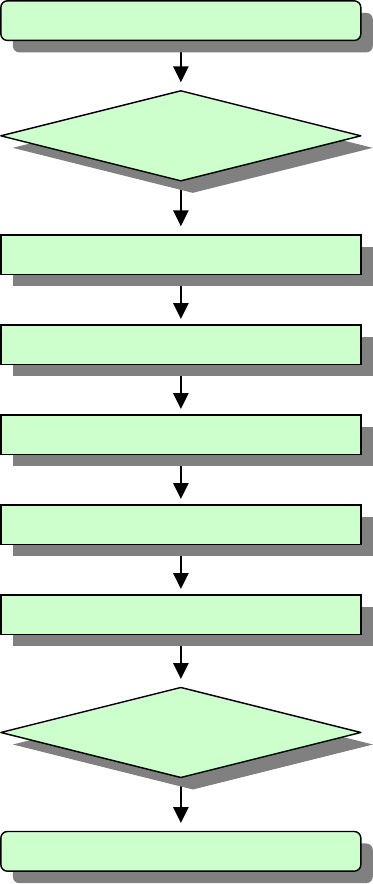
8
1. Installation Flow Chart
This document will provide details on how to successfully install the Juni JR-10 SOHO
Repeater system. The flow chart below shows the main steps involved in setting up the
equipment.
Fig. 1 Installation Flow Chart
1. Start
3. Locating
4. Band Setting
5. Link Ant
6. Power / Optimization
7. CU
9. End
8. Status Check
2. Package Check
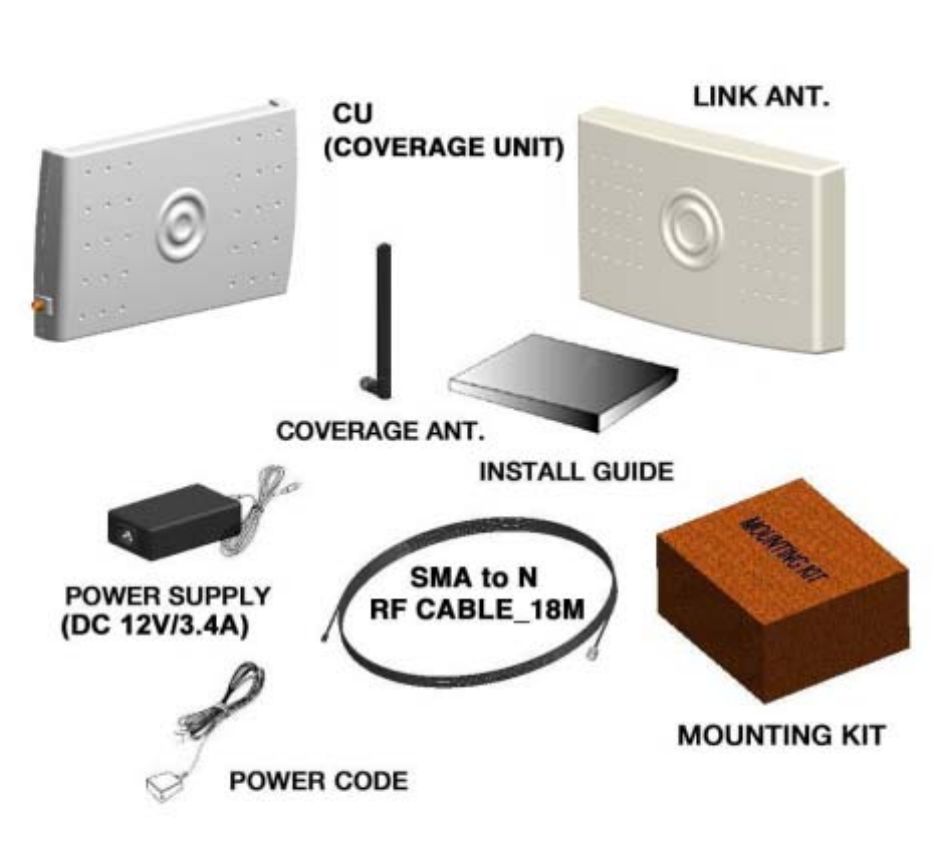
9
2. Package Check
The first step when installing the repeater is to check if all components are present and that
the parts do not contain any visible faults. The figure below illustrates the items included in
the JR-10 SOHO Repeater Kit.
Fig. 2 List of all the Components in the System
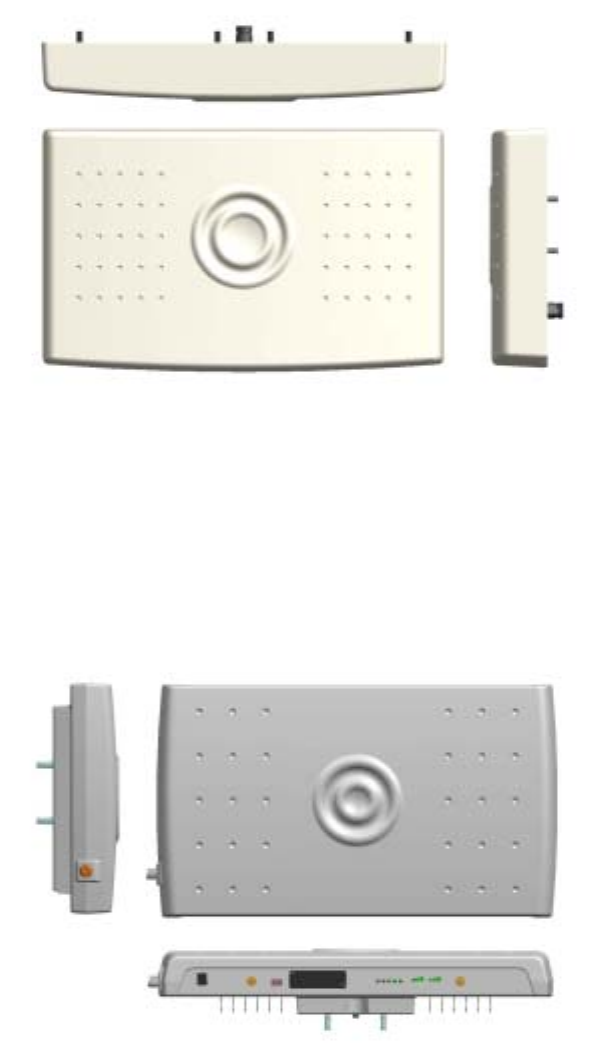
10
2.1 LINK ANT
Î The role of the Antenna Unit is to communicate with the BTS. It is usually located
outside the building where service is to be improved. The Antenna Unit can be mounted
onto a wall or a pole, depending on the specific installation needs.
Fig. 3 LINK ANT
2.2 COVERAGE UNIT (CU)
Î The role of the Coverage Unit is to communicate with the mobiles within the building
where needs improved coverage. It is intended for wall mounting.
Fig. 4 COVERAGE UNIT (CU)
11
3. Preparing for Antenna Unit and Coverage Unit Installation
Determining the installation location of the unit is viewed as one of the most important
choices, as the place of choice of the unit will heavily impact the overall performance of the
repeater.
The first selection that needs to be made by the user is to determine if the units will be
mounted to a wall or a pole. Once this decision has been confirmed, the choice of location
can be arranged.
When determining the position of the Antenna Unit, the following points should be considered.
Î Will the Antenna Unit be mounted on a Wall or a pole?
Î Is a BTS visible near site location?
Î Avoid areas where may possibly hinder the communication between the Antenna Unit and
the BTS such as large walls.
Î The Antenna Unit should be installed less than than10 feet away from the wall penetration
or window which will provide access to the inside of the building.
The following points should be considered when determining the location of the Coverage
Unit
Î Attempt to position the Coverage Unit at the center of desired service region
Î Attempt to position the Coverage Unit so that it is clearly visible.
Î Make sure that the distance from the Coverage Unit to its power source is less than 20feet.
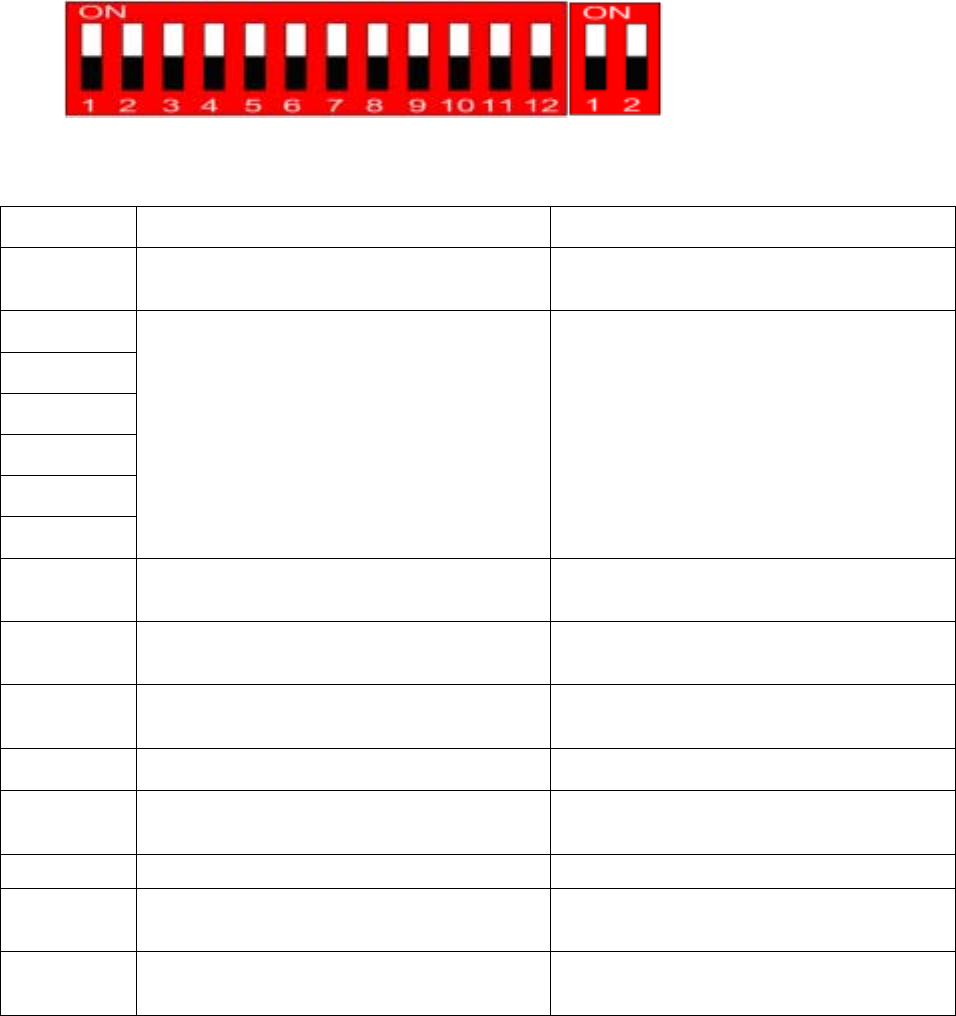
12
4. Frequency Band Setting
Once the location and positioning of the Antenna Unit and Coverage Unit are finalized, the
authorized installer should proceed with installing the Antenna Unit and Coverage Unit. But
first, the installer should set the appropriate operating frequency band(s) for the repeater,
based on Verizon Wireless licenses. The figure and table below show the DIP Switch settings.
Usually both PCS and Cellular bands have to be set up.
Î DIP Switch Functions
Fig. 5 DIP S/W 기본 Setting
PIN NO. FUNC TION STATUS
1 Cellular Band Selection ON : Cellular B Band
OFF : Cellular A Band
2
3
4
5
6
7
PCS Band Selection See the next tables below
8 PCS EVDO OFFSET ON : PCS Gain OFFSET 3dB(increase) ON
OFF : PCS Gain OFFSET 3dB(reduction) OFF
9 Cellular EVDO OFFSET
ON : Cellular Gain OFFSET 3dB(increase )ON
OFF : Cellular Gain OFFSET 3dB(reduction) OFF
10 Band Selection Mode ON : Software Band Selection Mode
OFF : Hardware Band Selection Mode
11 Uplink RF OFF ON : Reverse RF Power OFF
OFF : Reverse RF Power ON
12 Hardware Reset ON : Reset
OFF : Normal Operation
PIN NO. FUNC TION STATUS
1 PCS PATH HARDWARE ON/OFF ON : PCS UL/DL PATH HARDWARE ON
OFF : PCS UL/DL PATH HARDWARE OFF
2 CELLULAR PATH HARDWARE ON/OFF ON : CELLULAR UL/DL PATH HARDWARE ON
OFF : CELLULAR UL/DL PATH HARDWARE OFF
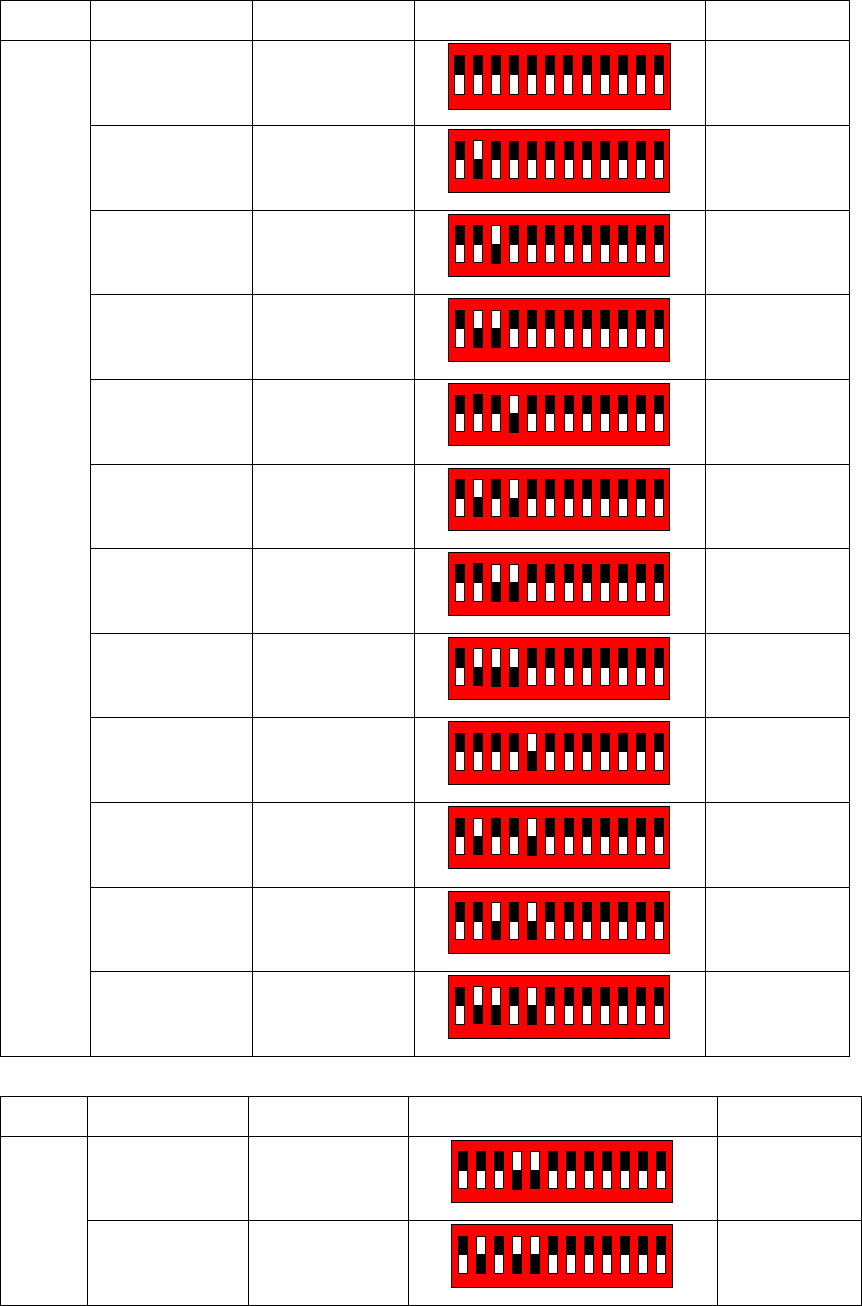
13
BW UP LINK DOWN LINK DIP SWITCH REMARK
1850 ~ 1855 1930 ~ 1935
123456789101112
ON
White color
is switch.
1855 ~ 1860 1935 ~ 1940
123456789101112
ON
1860 ~ 1865 1940 ~ 1945
123456789101112
ON
1865 ~ 1870 1945 ~ 1950
123456789101112
ON
1870 ~ 1875 1950 ~ 1955
123456789101112
ON
1875 ~ 1880 1955 ~ 1960
123456789101112
ON
1880 ~ 1885 1960 ~ 1965
123456789101112
ON
1885 ~ 1890 1965 ~ 1970
123456789101112
ON
1890 ~ 1895 1970 ~1975
123456789101112
ON
1895 ~ 1900 1975 ~ 1980
123456789101112
ON
1900 ~ 1905 1980 ~ 1985
123456789101112
ON
5MHz
1905 ~ 1910 1985 ~ 1990
123456789101112
ON
BW UP LINK DOWN LINK DIP SWITCH REMARK
1850 ~ 1860 1930 ~ 1940
123456789101112
ON
10MHz
1855 ~ 1865 1935 ~ 1945
123456789101112
ON
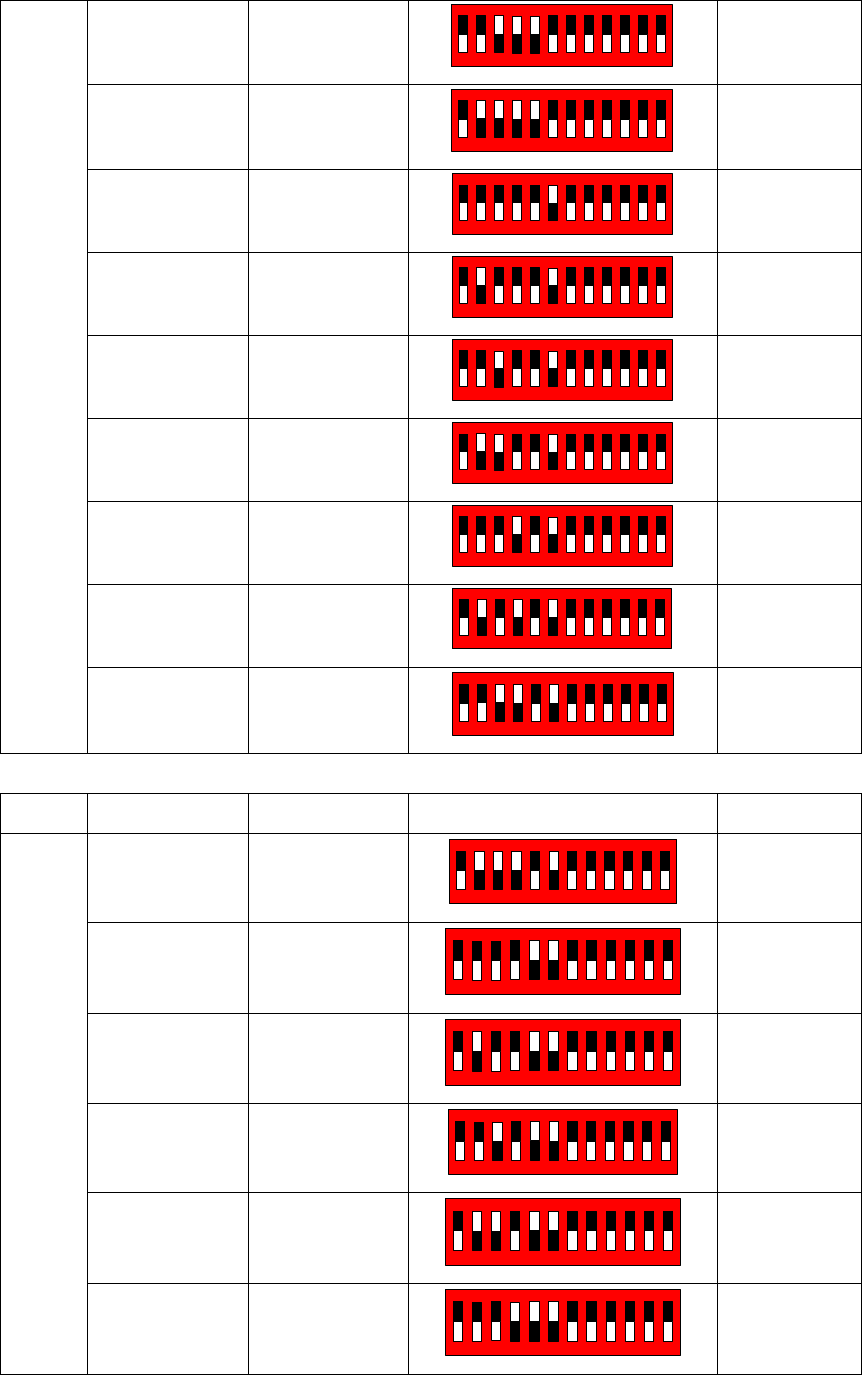
14
1860 ~ 1870 1940 ~ 1950
123456789101112
ON
1865 ~ 1875 1945 ~ 1955
123456789101112
ON
1870 ~ 1880 1950 ~ 1960
1 2 3 4 5 6 7 8 9 10 11 12
ON
1875 ~ 1885 1955 ~ 1965
1 2 3 4 5 6 7 8 9 10 11 12
ON
1880 ~ 1890 1960 ~ 1970
1 2 3 4 5 6 7 8 9 10 11 12
ON
1885 ~ 1895 1965 ~ 1975
1 2 3 4 5 6 7 8 9 10 11 12
ON
1890 ~ 1900 1970 ~ 1980
1 2 3 4 5 6 7 8 9 10 11 12
ON
1895 ~ 1905 1975 ~ 1985
1 2 3 4 5 6 7 8 9 10 11 12
ON
1900 ~ 1910 1980 ~ 1990
12345678 9101112
ON
BW UP LINK DOWN LINK DIP SWITCH REMARK
1850 ~ 1865 1930 ~ 1945
12 34 56 78 9101112
ON
1855 ~ 1870 1935 ~ 1950
12345678 9101112
ON
1860 ~ 1875 1940 ~ 1955
12345678 9101112
ON
1865 ~ 1880 1945 ~ 1960
12 34 56 78 9101112
ON
1870 ~ 1885 1950 ~ 1965
12345678 9101112
ON
15MHz
1875 ~ 1890 1955 ~ 1970
12345678 9101112
ON
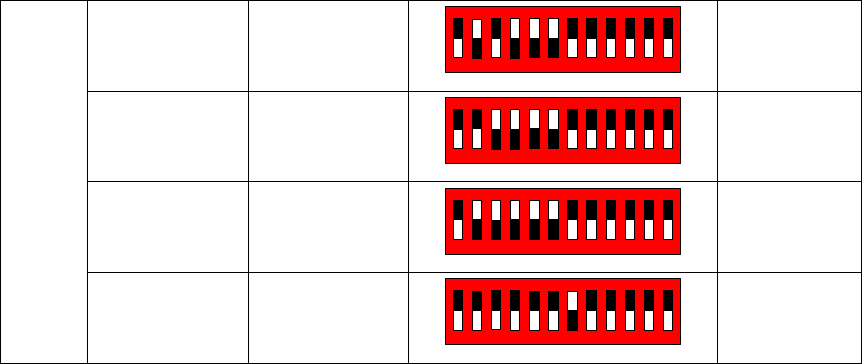
15
1880 ~ 1895 1960 ~ 1975
12345678 9101112
ON
1885 ~ 1900 1965 ~ 1980
12345678 9101112
ON
1890 ~ 1905 1970 ~ 1985
12345678 9101112
ON
1895 ~ 1910 1975 ~ 1990
12345678 9101112
ON
Table 1 Band Setting
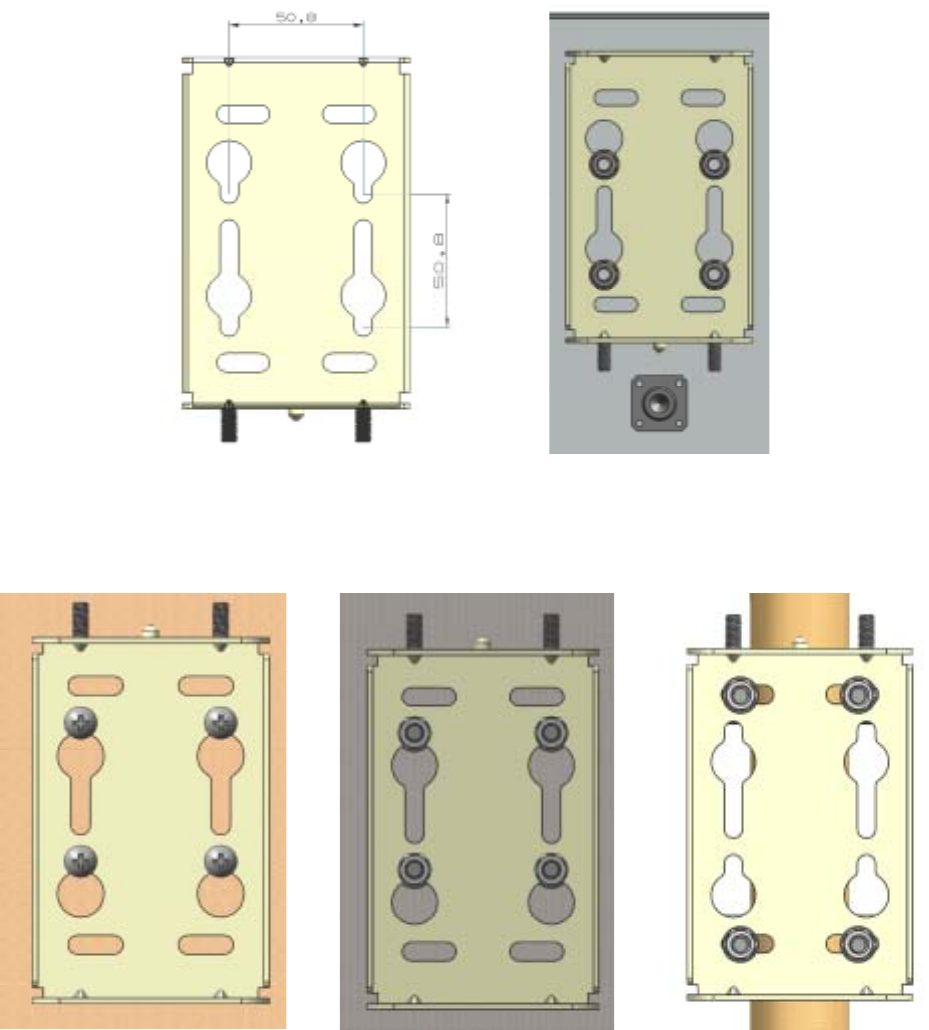
16
5. LINK ANT. Installation
5.1 BRACKET/MTG Image
5.1.1. LINK ANTENNA 에 BRACKET – ANT Connection Image
1) The length unit is [mm].
Fig. 6 LINK ANT MTG BRACKET_ANT Connection Image
5.1.2. BRACKET/MTG Connection Image to Installation Place(WALL or POLE)
( Lumber Wall ) ( Concrete Wall ) ( Pole )
Fig. 7 WALL or POLE MTG BRACKET_ANT Connection Image
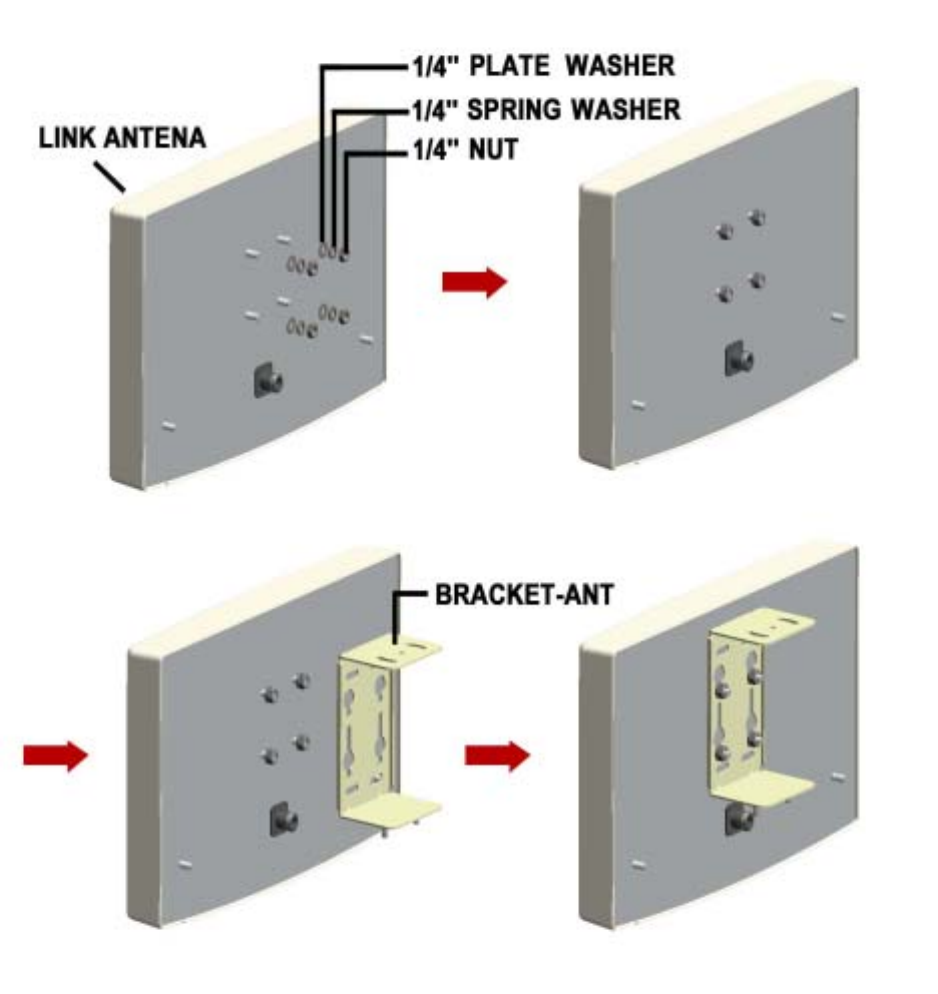
17
5.2 LINK ANT MTG Bracket Connection
1) APPLY 1/4” NUT, SPRING WASHER, PLATE WASHER to LINK ANT.
(Do not Connect Completely)
2) APPLY BRACKET-ANT TO LINK ANTENNA.
3) APPLY NUT COMPLETELY USING PROVIDED TOOL.
[1/4” NUT, 1/4” SPRING WASHER, 1/4” PLATE WASHER 4ea, BRACKER-ANT 1ea]
Fig. 8 LINK ANT 에 MTG BRACKET_ANT Connection Image
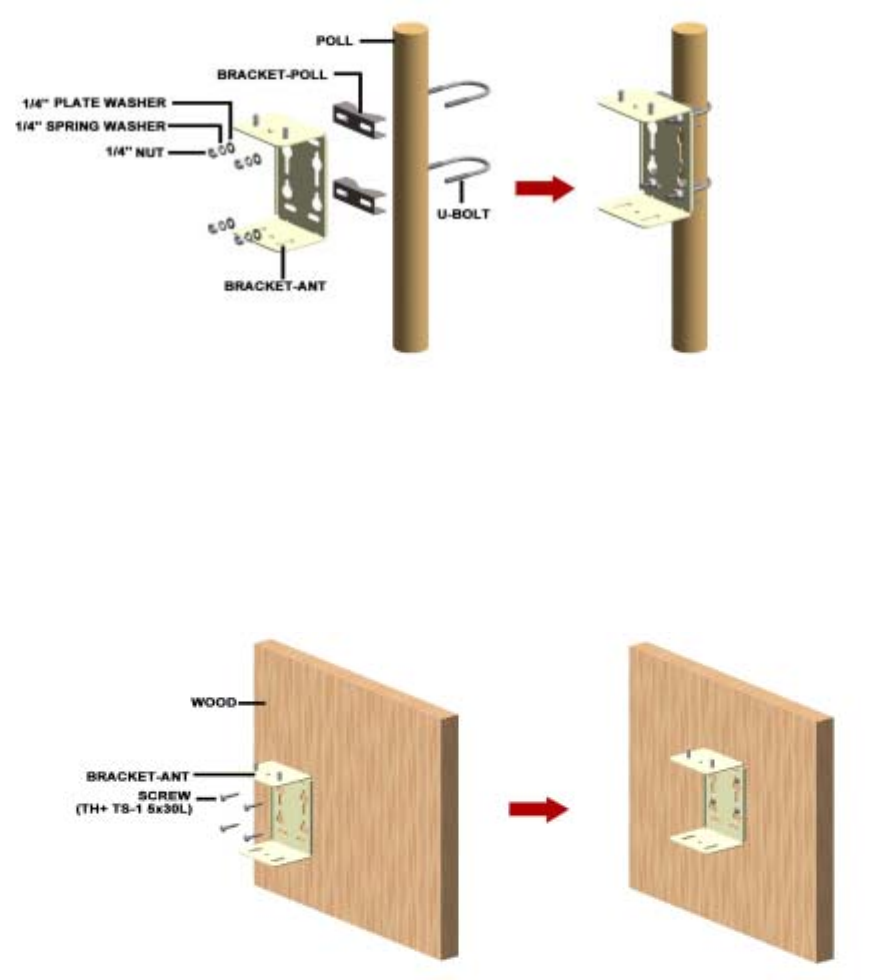
18
5.3 BRACKET Connection depending on Installation Place
5.3.1. POLE MOUNTING
1) Secure DU to the pole using U-BOLT.
2) Insert U-BOLT to between BRACKET-POLE and BRACKET-DU
3) Apply the pole to the BRACKET-DU: use the nuts and u-bolts provided to fixate the
bracket into the Pole.
[BRACKET-ANT 1ea, BRACKET-POLE 2ea, U-Bolt 2ea, 1/4” NUT, 1/4” SPRING WASHER,
1/4” PLATE WASHER each 4ea]
Fig. 9 POLE MOUNTING MTG BRACKET_ANT Connection Sequence
5.3.2. LUMBER WALL MOUNTING
1) Secure BRACKET-DU to the wooden wall. Using cross driver connect SCREW to wooden
wall through BRACKET-DU.
[BRACKET-ANT 1ea, SCREW (TH+ TS-1 5x30L) 4ea]
Fig. 10 LUMBER WALL MOUNTING MTG BRACKET_ANT Connection Sequence
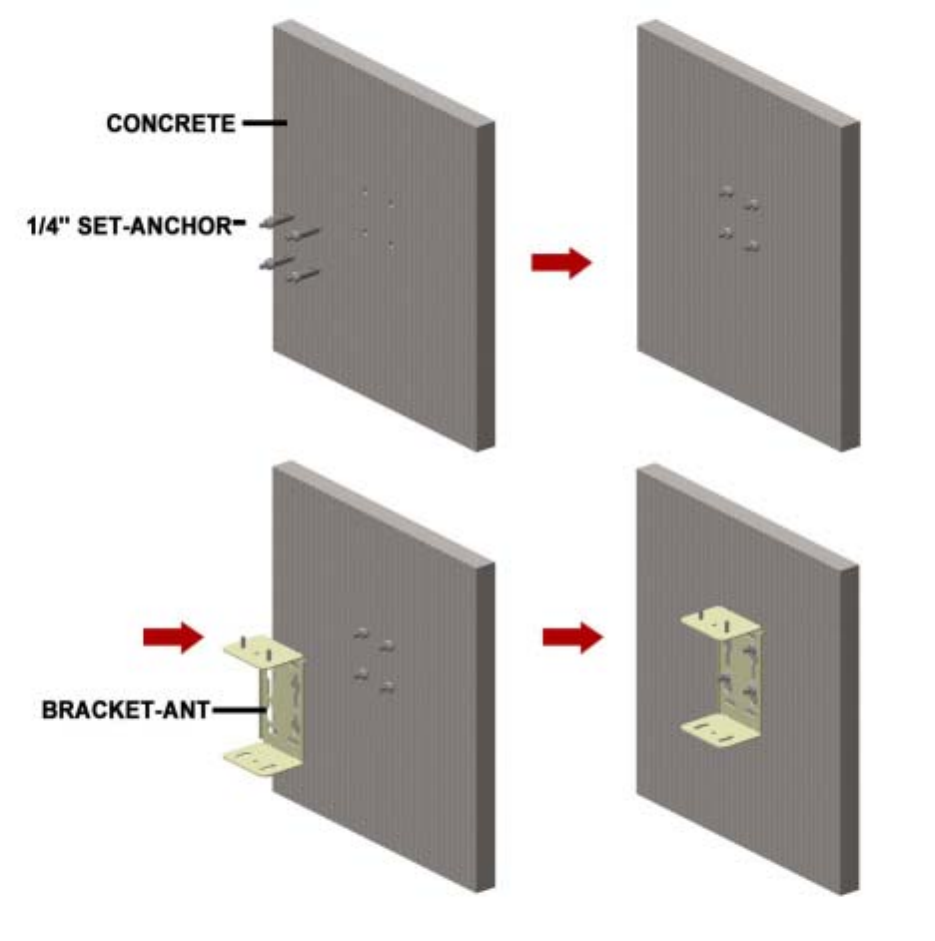
19
5.3.3. CONCRETE WALL MOUNTING
1) Drill on the wall as the BRACKET-ANT distance.(forφ 10mm Hole depth to be 30 to 40 mm.
2) INSERT SET-ANCHOR TO DRILLED HOLE.
3) Secure BRACKET-DU to the Wall and fix the nut.
[SET-ANCHOT 4ea, BRACKER-ANT 1ea]
Fig. 11 CONCRETE WALL MOUNTING MTG BRACKET_ANT Connection Sequence

20
5.4 LINK ANTENNA Connection (same as 5.2) with BRACKET (same as 5.3)
1) APPLY LINK ANTENNA to the BRACKET.
2) Apply the NUT to the upside of BRACKET like below sequence. – Do not apply the NUT
completely.
3) Set the receiving direction of the ANTENNA and apply the NUT completely using the
provided tool.
[1/4” NUT, 1/4” SPRING WASHER, 1/4” PLATE WASHER 각 4ea]
Fig. 12 LINK ANT Connection Sequence to Installed MTG BRACKET-ANT

21
5.5 Installation Completion.
Fig. 13 LUMBER WALL MOUNTING
Fig. 14 CONCRETE WALL MOUNTING
Fig. 15 POLE MOUNTING
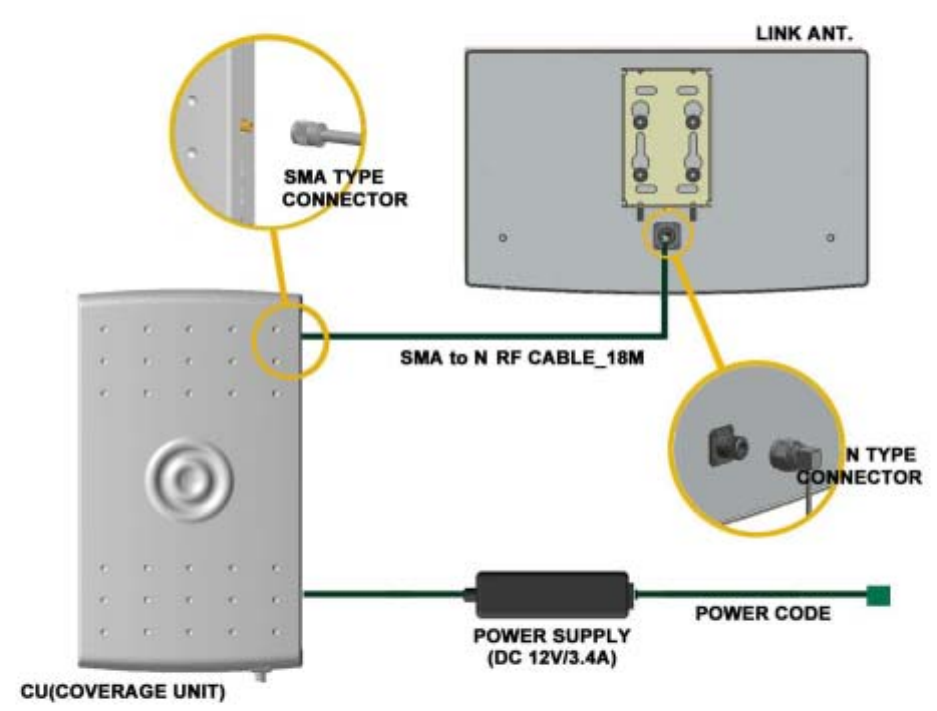
22
6. Power Connection and Optimization SETTING
Once the Antenna Unit, RF Cable and Coverage Unit have been successfully installed, the
authorized installer should connect the Power Adaptor and AC power to the equipment and
make the correct system settings. The Coverage Unit LED indicator is needed when
proceeding with the optimization setting.
1) Connect the RF Cable between the Antenna Unit and the Coverage Unit as shown in the
diagram below. The Power Adaptor should also be connected to the appropriate location on
the Coverage Unit.
Fig. 16 Power PORT Connection
2) Once the power has been successfully connected (this can be verified by checking the LEDs on
the Coverage Unit), the Antenna Unit has to be positioned so that maximum signal level is being
received from the BTS. This can be monitored via the Coverage Unit LEDs which indicate the signal
strength (RSSI) reading.
(It is recommended for the RSSI LEDs show at least 3 bars)

23
Fig. 17 Verifying reception status
Outdoor LINK ANT. on a Roof (Pole mount) Outdoor LINK ANT. (Wall mount)
Once the Antenna Unit is mounted onto the pole, it
is capable of being rotated 20° in either direction.
The Antenna Unit can also be mounted anywhere
around the pole.
Can be rotated 20° in either direction
Fig. 18 LINK ANT Tilting
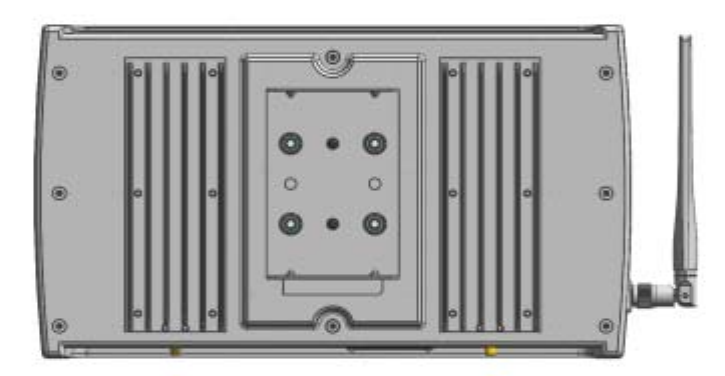
24
3) The type of mounting method used will determine how much flexibility it has in revolving
from its position.
7. RF UNIT(CU) Installation (Wall & Ceil Mount)
1) Using the Coverage Unit Mounting Bracket as a drilling template, drill Coverage Unit
Mounting Bracket holes into the wall for the appropriate mounting hardware, depending on
the type of wall (concrete, drywall, plaster, wood, veneer). Install the appropriate mounting
hardware and the install Coverage Unit Mounting Bracket as shown in the diagram below.
2) Use the nuts and flat washers to attach the Outer Bracket to the Coverage Unit. The
Coverage Unit is then secured to the Coverage Unit Mounting Bracket with 2 screws
provided.
3) Connect the Coverage Antenna to the Coverage Unit.
7.1 CU INSTALL BRACKET Image
7.1.1. BRACKET – CU SET Connection with CU Image
Fig. 19 MTG BRACKET – CU SET Connection Image
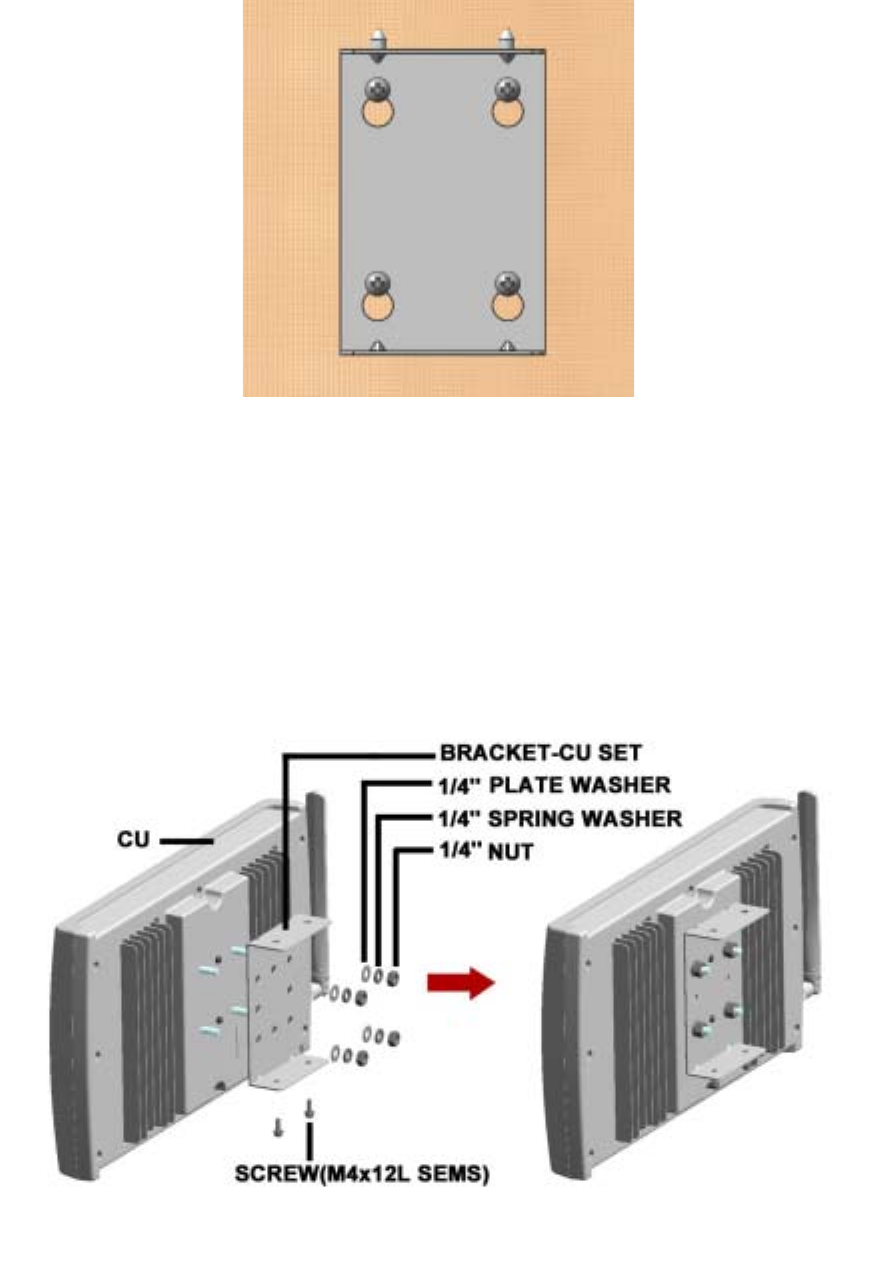
25
7.1.2. BRACKET- CU MTG Connection to Wall Image
Fig. 20 MTG BRACKET – CU Connection Image
7.2 INSTALL BRACKET Connection to CU
1) Apply BRACKET – SET to CU completely using NUT, SPRING and PLATE WASHER.
2) Apply SCREW to BRACKET – SET suitably. (not completely)
[CU BRACKET-SET 1ea, BRACKET SCREW 2ea, NUT, SPRING WASHER,
PLATE WASHER 각 4ea]

26
Fig. 21 MTG Bracket – CU SET Connection Sequence
7.BRACKET Connection depending on Installation Place
7.3.1. LUMBER WALL MOUNTING
1) Secure BRACKET-CU MTG to the wooden wall. Using cross driver, connect completely
SCREW to wooden wall through BRACKET-MTG.
[CU BRACKET-MTG 1ea, SCREW 4ea]
Fig. 22 LUMBER WALL MTG Bracket MOUNTING

27
7.3.2. GYPSUM BOARD WALL MOUNTING
1) Secure DRYWALL anchor to the GYPSUM BOARD WALL using cross driver completely.
2) Secure DRYWALL anchor screw to BRACKET – CU MTG using cross driver completely.
[BRACKET-CU MTG 1ea, Drywall Anchor 4ea, Screw 4ea]
Fig. 23 GYPSUM BOARD WALL MTG Bracket MOUNTING
7.3.3. CONCRETE WALL MOUNTING
1) Secure PLASTIC ANCHOR TO WALL. (Removal is impossible after connection.)
: INSERT PLASTIC ANCHOR after drill φ 6mm Hole in the wall by 30~40mm depth
[CU BRACKET-MTG 1ea, PLASTIC ANCHOR 4ea]
Fig. 24 CONRETE WALL MTG Bracket MOUNTING
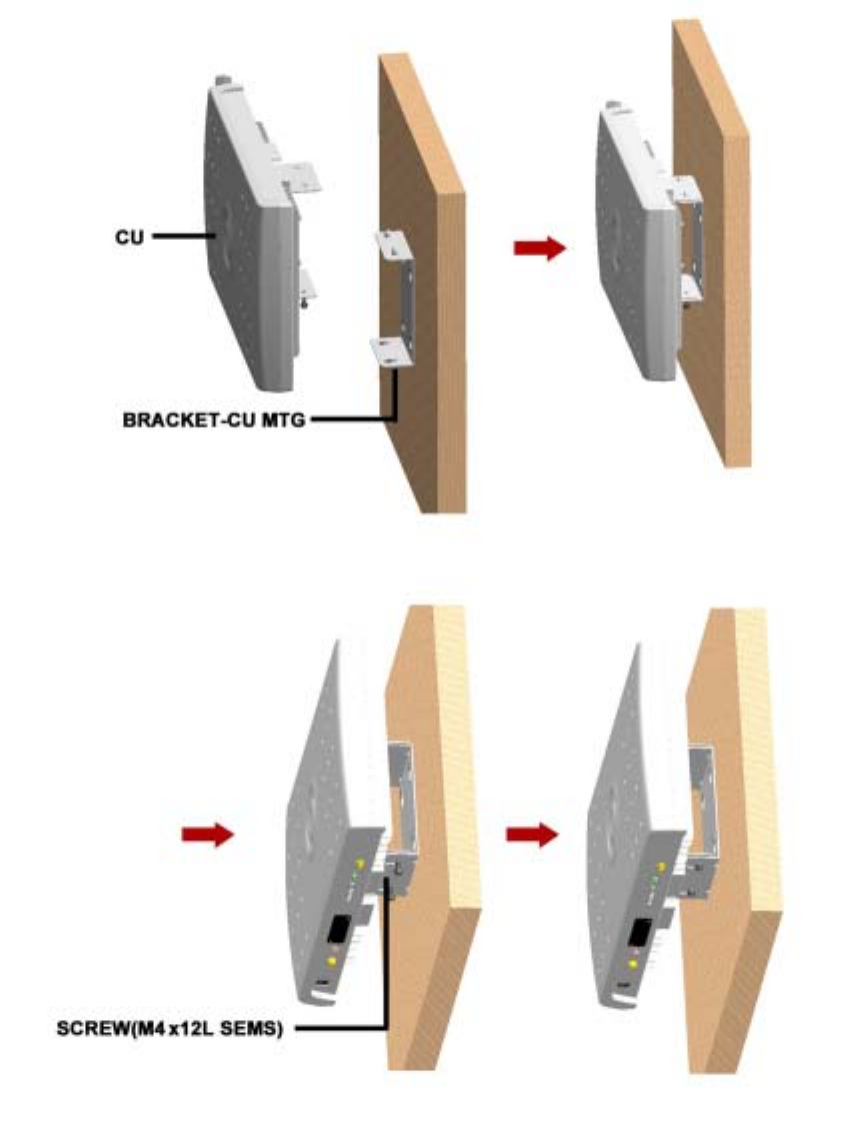
28
7.4 Connection CU(same as 7.2) with CU BRACKET-MTG(same as 7.3)
1) APPLY CU to BRACKET-CU MTG.
2) After securing CU to Wall, connect the SCREW (M4X12L SEMS) to the BRACKET.
[SCREW(M4X12L SEMS) 2ea]
Fig. 25 CU Connection to Installed BRACKET –CU MTG Sequence

29
7.5 Installation Completion.
Fig. 26 CU SET Installation Completion Image
5) Once the positioning of the Coverage Unit has been finalized, use the DIP Switch to activate the
Uplink path.
Fig. 27 DIP S/W Diagram
1234567891011 1234567891011
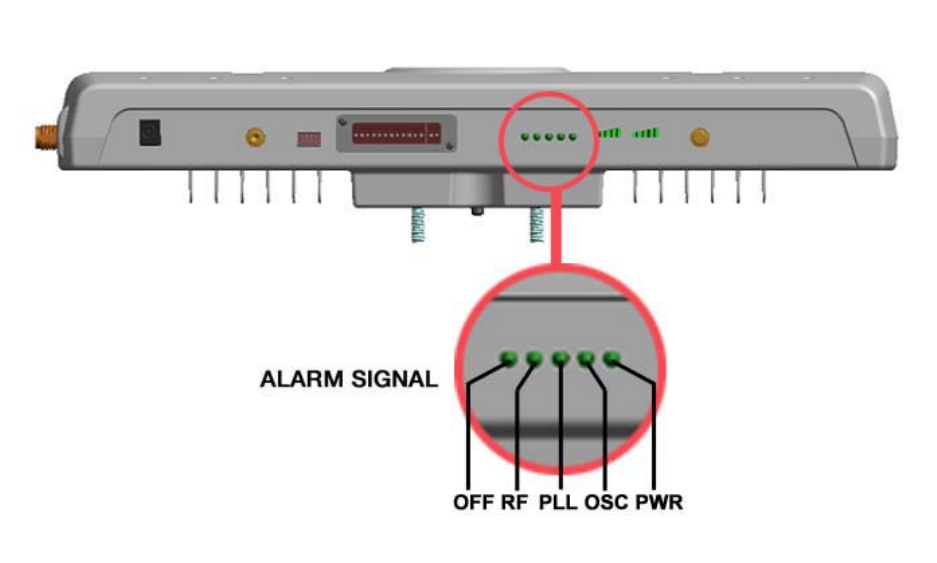
30
8. Status Check
8.1 Coverage Unit Alarm LEDs
If any Alarm LED is activated:
A red LED will indicate that the equipment is not functioning properly. Each of the LEDs
represents the status of a specific section of the system as shown below
Fig. 28 Coverage Unit LED
▶ MANUAL OFF – If the authorized installer decides to turn off the system, this LED will turn
red.
▶ RF – If the output RF power level exceeds the pre-set limit or if oscillation is present, the
equipment will automatically shut down and the RF LED will turn RED.
▶ PLL – Malfunction of the Frequency setting circuitry will cause this LED to turn RED.
▶ OSC – Will turn RED when it detects oscillation
▶ POWER – If the RF input level is not within the range set by the authorized installer or the
system identifies a problem during operation, this LED will turn RED.
31
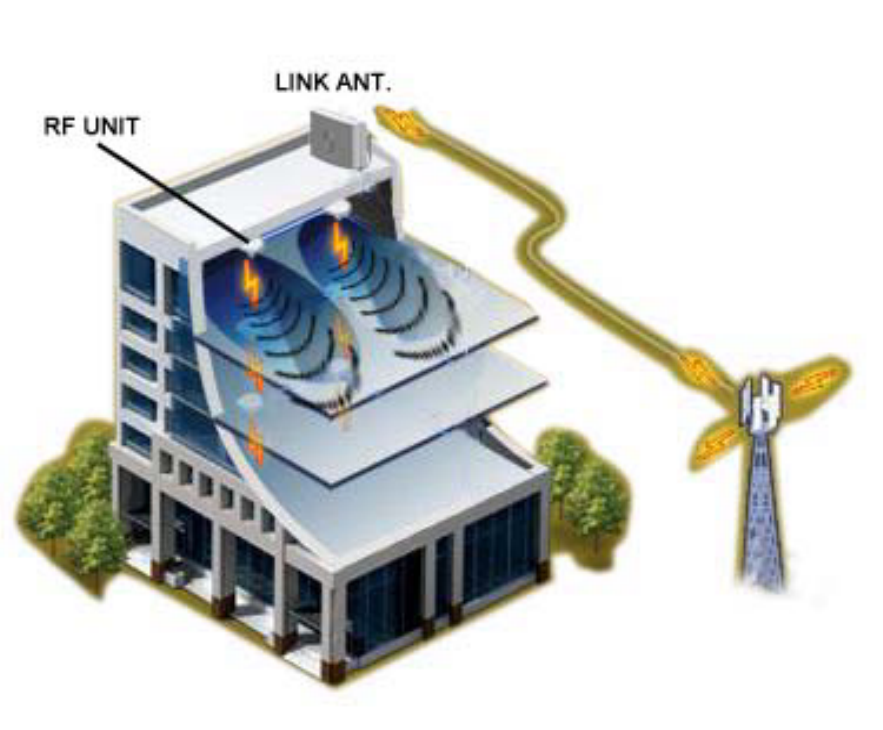
32
Appendix A. Product Introduction
A.1 1 Overview
The Juni JR-10 SOHO Repeater system is an RF repeater which provides coverage for indoor
locations within a BTS coverage area. The repeater is intended to serve indoor locations
where there is very little or no RF coverage. The system supports both US Cellular and PCS
bands. Verizon Wireless-authorized installation personnel are able select to bands via the
internal band selection function. The Juni JR-10 SOHO Repeater is intended for indoor
environments of up to 2500 sq.ft. The system configuration includes an Antenna Unit which is
typically located outside the building and a Coverage Unit which is positioned at the
approximate center of the indoor space requiring better coverage. The role of the Antenna
Unit is to provide the link between the repeater system and the BTS. The Coverage Unit is
intended to communicate with Mobiles located indoors.
Fig. 29 System Configuration
33

34
The diagram below shows the basic system configuration. It can be seen that the RF cable
connects the LINK ANT to the CU. The power cable is also connected to the CU.
Fig. 30 Basic Connection

35
A.2 Requirements and limitations when installing the Repeater system
▶ Operator : Verizon Wireless
▶ Frequency Band in Use : CELLULAR or PCS
Î CELLULAR Frequency Range
Î Cellular Band: (B1 and B2) or (A1 and A2) depending on Verizon Wireless’ Cellular Band license
for the area where the repeater is to be installed.
Table 2 Cellular Frequency
Î PCS Frequency Range
Î Cellular Band (1850-1990) : 1 tunable, non-contiguous PCS band of 5, 10 or 15 MHz
depending on Verizon Wireless’ PCS band license for the area where the repeater is to be
installed.
Table 3 PCS Frequency Band
36

37
Appendix B. System Specifications
Frequency Bands PCS Uplink : 1850 – 1910MHz Downlink : 1930 – 1990MHz
CELL Uplink : 824 – 849MHz Downlink : 869-894 MHz
Sub-Bands Cell : A+A’, B+B’ PCS : 5 , 10 , 15 MHz
Formats Supported IS-95 / CDMA / 1X EVDO
Typical Coverage Area 2,500 sq. ft
System Gain(Eirp) CEL Up link : 63dB , CEL Down link : 67dB
PCS Up link : 69dB , PCS Down link : 73dB
Downlink Operating Range ~ -55dBm (Receive isotropic power)
Output Level(MAX Eirp) CEL UPLINK : +20dBm, CEL DOWNLINK : -6dBm
PCS UPLINK : +17dBm, PCS DOWNLINK : +2dBm
Third Order Intercept(Eirp)
- typical
CEL DL : 10dBm , CEL UL : 38dBm
PCS DL :17dBm , PCS UL : 33dBm
Power Consumption < 40W
부가 기능 AGC FUCNTION, BRING DOWN, OVERDRIVE, OVERPOWER
Table 4 RF Specifications
LINK ANT. COVERAGE UNIT
OPERATING TEMPERATURE -20 ℃ ~ 50 ℃ 0 ℃ ~ 40 ℃
SIZE 389(W) X 236(H) X 58.5 (D) 360(W) X 210(H) X 60 (D)
WEIGHT 1.6Kg 1.4Kg
RF CONNECTORS N TYPE LINK ANT: SMA
COVERAGE ANT : TNC TYPE
POWER SUPPLY < 40W
Table 5 Physical Specifications
CELL PCS
LINK ANT. ANT CU ANT LINK ANT. ANT CU ANT
GAIN(dBi) 10 0 10 0
Elevation Beamwidth-typical(dg) 65° >90° 50° >90°
Azimuth Beamwidth-typical(dg) 40° NA 30° NA
Front-to-Back Ratio(dB) > 15dB NA > 15dB NA
Polarization Vertical
Table 6 Antenna Specifications

38
Appendix C. System Block
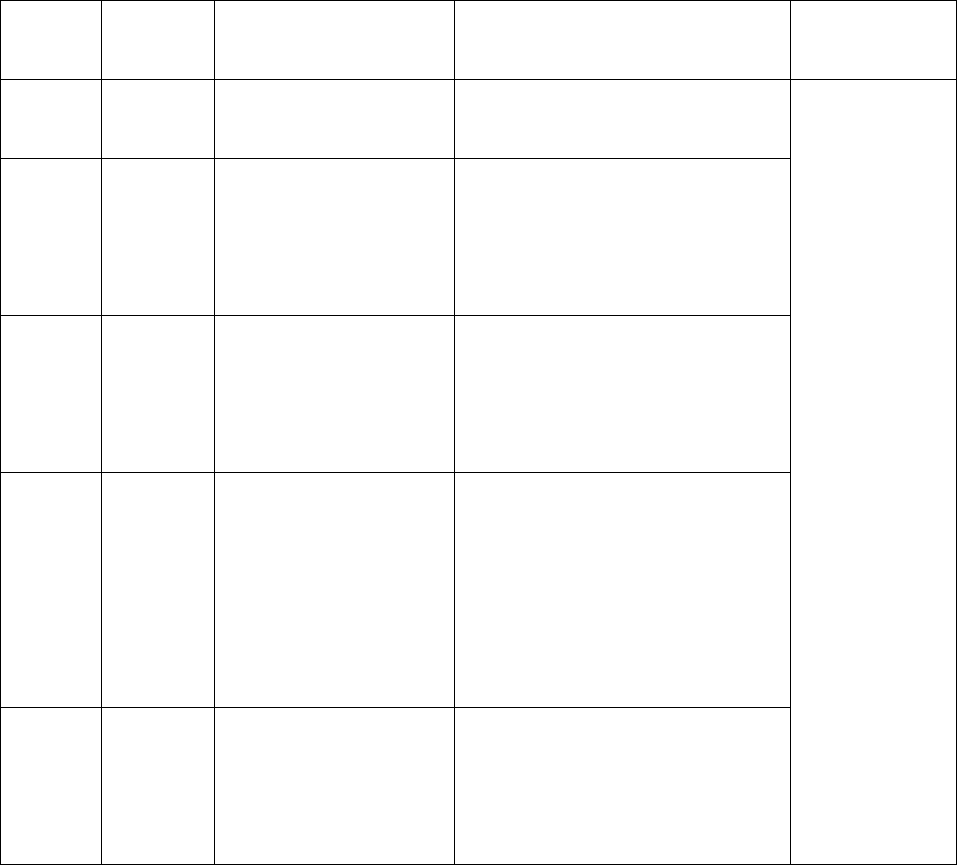
39
Appendix D. Troubleshooting for JR-10 SOHO Repeater
Alarm LED
Color Possible Reason Action Required Action
MANUAL
OFF
Green
-> Red
When service provider
forces the System OFF
Check Alarm
-> Call Juni Technical Support
RF Green
-> Red
Shutdown by
Excessive Output
Power or System
Oscillation
- Excessive Output Power:
Automatically Recovered.
Call Juni Technical Support if
repeated
PLL Green
-> Red Repeater Failure
Check Alarm
-> Power ON/OFF
Call Juni Technical Support if
not improved
OSC Green
-> Red
SYSTEM SHUT DOWN
DUE TO OSCILLATION
- Oscillation: Wrong Antenna
Unit direction or Antenna Unit
and Coverage Unit installed too
close to one another
- Call Juni Technical Support if
not improved
Power Green
-> Red
Input Power – Out of
Range
Operating Current –
Out of Range
Check Alarm
-> Check the AC Power Adaptor
-> Call Juni Technical Support if
not improved
Juni Technical
Support